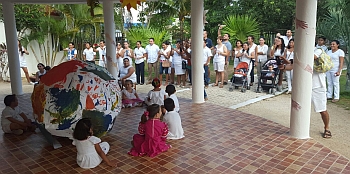Archivo de septiembre 2015
Children are not complicated…
 September 21st we celebeated the International Day of Peace. It was very joyfull to listen to the kids voices when they read theis messages of peace and then sent them to the blue sky. Children are always looking for happiness, that is their natural way of living in harmony and peace. It is us, the adults who complicate the situations.
September 21st we celebeated the International Day of Peace. It was very joyfull to listen to the kids voices when they read theis messages of peace and then sent them to the blue sky. Children are always looking for happiness, that is their natural way of living in harmony and peace. It is us, the adults who complicate the situations.
In this post we want to share a text written by Catherine McTamaney. A beautiful reflexion to see that everytime is a good time to take good opportunities.
How complicated are the children. Really? We can track their development, predict emerging skills, judge their growth spurts, and chart their progress. Doesn’t it all look pretty much the same in the end? Children come to us, they learn with us, they move on. Three-year-olds become four-year-olds. Four-year-olds become five-year-olds. And so on. And on. And on.
 Over time, over children, we grow more comfortable in what to expect, and so can better understand the child whose development is surprising. But in that comfort, we can sometimes project on to children what we expect of their development, when we should be responding to it because we have seen it concretely in each child. Don’t the children all become wild in the spring? Isn’t December always a difficult month? Doesn’t the best work of the year happen in January and February? Perhaps, Maybe not.
Over time, over children, we grow more comfortable in what to expect, and so can better understand the child whose development is surprising. But in that comfort, we can sometimes project on to children what we expect of their development, when we should be responding to it because we have seen it concretely in each child. Don’t the children all become wild in the spring? Isn’t December always a difficult month? Doesn’t the best work of the year happen in January and February? Perhaps, Maybe not.
 Remember the secret of childhood? What is the secret? That inner drive that push that we cannot perceive, that we can no longer understand because we are no longer children. In our loss of words, we seek other ways to demystify children. We track and predict and judge and chart. We put children’s development onto clearly defined, carefully laid-out spread-sheets for their parents to understand. We justify. Checklists are easier for teacher to complete. They are easier for parents to understand. But what about the details that don’t fit into the boxes? We overlook the unique wonderment of each child by focusing instead on the predictors that we have chosen. We come up with our list of the individual traits that we value, and we check off when the child has shown them, and so abdicate our duty to continue to try to perceive the uncountable galaxies within each child.
Remember the secret of childhood? What is the secret? That inner drive that push that we cannot perceive, that we can no longer understand because we are no longer children. In our loss of words, we seek other ways to demystify children. We track and predict and judge and chart. We put children’s development onto clearly defined, carefully laid-out spread-sheets for their parents to understand. We justify. Checklists are easier for teacher to complete. They are easier for parents to understand. But what about the details that don’t fit into the boxes? We overlook the unique wonderment of each child by focusing instead on the predictors that we have chosen. We come up with our list of the individual traits that we value, and we check off when the child has shown them, and so abdicate our duty to continue to try to perceive the uncountable galaxies within each child.
 If we are unable to easily give details, if It is too difficult or time consuming to describe the unique wonderment of each child, we are not paying close enough attention. Montessori is based on the attention to each individual. Children come before our manuals. We should know, at any moment, the endless ways in which two children are different, or we are not watching carefully enough. Using a checklist for its simplicity has its merits. But don’t pretend that children are simple. Leave space for the unexpected, and know that every child is unexpected.
If we are unable to easily give details, if It is too difficult or time consuming to describe the unique wonderment of each child, we are not paying close enough attention. Montessori is based on the attention to each individual. Children come before our manuals. We should know, at any moment, the endless ways in which two children are different, or we are not watching carefully enough. Using a checklist for its simplicity has its merits. But don’t pretend that children are simple. Leave space for the unexpected, and know that every child is unexpected.
The secret of good teaching is to regard the child’s intelligence as a fertile field in which seed may be sown, to grow under the heat of flaming imagination. Maria Montessori.
Los niños no son complicados…
 El 21 de septiembre celebramos el Día Internacional de la Paz. Fue muy emotivo escuchar las voces de los niños, leer sus mensajes y lanzarlos al viento. Los niños buscan la felicidad, buscan la armonía, saben vivir la paz de manera natural, pero, recordemos que los niños nos observan e imitan lo que nosotros les mostramos. Es así como el adulto va complicando las situaciones. En esta ocasión queremos compartir un texto escrito por Catherine McTamaney. Una linda reflexión de cómo cada momento es un punto de oportunidad.
El 21 de septiembre celebramos el Día Internacional de la Paz. Fue muy emotivo escuchar las voces de los niños, leer sus mensajes y lanzarlos al viento. Los niños buscan la felicidad, buscan la armonía, saben vivir la paz de manera natural, pero, recordemos que los niños nos observan e imitan lo que nosotros les mostramos. Es así como el adulto va complicando las situaciones. En esta ocasión queremos compartir un texto escrito por Catherine McTamaney. Una linda reflexión de cómo cada momento es un punto de oportunidad.
“El secreto de la buena enseñanza, es considerar la inteligencia del niño como
un campo fértil en el que la semilla puede ser sembrada,
para poder crecer bajo el calor de la llama de la imaginación.” María Montessori.
 ¡Qué complicados son los niños! ¿En serio? Podemos rastrear su desarrollo, predecir las habilidades emergentes, juzgar sus brotes de crecimiento y trazar su progreso. ¿No hace que todo parezca más o menos igual al final? Los niños vienen a nosotros, aprenden con nosotros y se van. Tres años de edad que se convierten en cuatro años. Cuatro años de edad que se convierten en cinco años. Y así, etcétera, etcétera, etcétera.
¡Qué complicados son los niños! ¿En serio? Podemos rastrear su desarrollo, predecir las habilidades emergentes, juzgar sus brotes de crecimiento y trazar su progreso. ¿No hace que todo parezca más o menos igual al final? Los niños vienen a nosotros, aprenden con nosotros y se van. Tres años de edad que se convierten en cuatro años. Cuatro años de edad que se convierten en cinco años. Y así, etcétera, etcétera, etcétera.
Con el tiempo, mientras más trabajamos con los niños, vamos creciendo sintiéndonos más cómodos con nuestras espectativas, y así podemos entender mejor al niño cuyo desarrollo es sorprendente. Pero en ese confort, a veces podemos proyectar a los hijos basándonos en lo que esperamos de su desarrollo, cuando en realidad deberíamos estar respondiendo a ese desarrollo, porque lo hemos visto concretamente en cada niño. No todos los niños tienen la misma actitud ante la primavera. No es siempre diciembre un mes difícil. ¿Acaso siempre el mejor trabajo del año ocurre en enero o febrero? Tal vez, tal vez no.
 Recuerda el secreto de la infancia, ¿cuál es el secreto? Es esa unidad interior que empuja y que no podemos percibir, que ya no podemos entender porque ya no somos niños. En nuestra pérdida de palabras, buscamos otras formas de desmitificar a los niños. Hacemos un seguimiento y predecimos y juzgamos, hasta graficamos. Ponemos el desarrollo de los niños en cuadros claramente definidos, cuidando el montaje de técnicas repartidas para que los padres entiendan. Nos justificamos. Las listas de verificación son más fáciles de compilar para el profesor y es más fácil que los padres las entiendan. Pero, ¿qué pasa con los detalles que no encajan en los cuadros predispuestos? Pasamos por alto la maravilla única de cada niño, centrándonos en cambio en las predicciones que hemos elegido. Nos encontramos con nuestra lista de los rasgos individuales que valoramos y comprobamos cuando el niño los ha mostrado y así abdicamos a nuestro deber de seguir al niño para tratar de percibir las galaxias incontables que habitan dentro de cada niño.
Recuerda el secreto de la infancia, ¿cuál es el secreto? Es esa unidad interior que empuja y que no podemos percibir, que ya no podemos entender porque ya no somos niños. En nuestra pérdida de palabras, buscamos otras formas de desmitificar a los niños. Hacemos un seguimiento y predecimos y juzgamos, hasta graficamos. Ponemos el desarrollo de los niños en cuadros claramente definidos, cuidando el montaje de técnicas repartidas para que los padres entiendan. Nos justificamos. Las listas de verificación son más fáciles de compilar para el profesor y es más fácil que los padres las entiendan. Pero, ¿qué pasa con los detalles que no encajan en los cuadros predispuestos? Pasamos por alto la maravilla única de cada niño, centrándonos en cambio en las predicciones que hemos elegido. Nos encontramos con nuestra lista de los rasgos individuales que valoramos y comprobamos cuando el niño los ha mostrado y así abdicamos a nuestro deber de seguir al niño para tratar de percibir las galaxias incontables que habitan dentro de cada niño.
 Si no somos capaces de dar fácilmente los detalles, si es demasiado difícil o requiere mucho tiempo para describir la maravilla única de cada niño, no estamos prestando suficiente atención. Montessori se basa en la atención a cada individuo. Los niños vienen ante nuestros manuales. Debemos saber, en todo momento, las infinitas maneras en que dos niños son diferentes, o no estamos viendo con suficiente cuidado a cada individuo. El uso de una lista de verificación para su simplicidad tiene sus méritos. Pero no pretendamos que los niños sean simples. Dejemos espacio para lo inesperado, y es importante saber que ¡cada niño es inesperado!
Si no somos capaces de dar fácilmente los detalles, si es demasiado difícil o requiere mucho tiempo para describir la maravilla única de cada niño, no estamos prestando suficiente atención. Montessori se basa en la atención a cada individuo. Los niños vienen ante nuestros manuales. Debemos saber, en todo momento, las infinitas maneras en que dos niños son diferentes, o no estamos viendo con suficiente cuidado a cada individuo. El uso de una lista de verificación para su simplicidad tiene sus méritos. Pero no pretendamos que los niños sean simples. Dejemos espacio para lo inesperado, y es importante saber que ¡cada niño es inesperado!
Comentarios recientes